University Risk Management Planning: Case Study Analysis Report
VerifiedAdded on 2022/10/09
|20
|4943
|17
Report
AI Summary
This report presents a comprehensive analysis of risk management planning, using a case study of a Singapore-based organization facing negative publicity due to a failed charity event. The report identifies the organization's strategic management plan deficiencies, including lack of strategic analysis, inadequate employee involvement, and failure to consider potential risks. It proposes a detailed risk management plan with specific risk categories, probability of occurrence, impact levels, and timeframes for mitigation. The plan covers areas such as strategic management, financial management, and legal compliance, emphasizing the importance of stakeholder involvement, effective communication, and adherence to legal and ethical standards. The report includes visual aids like risk matrices and frameworks to illustrate the risk management process and its components. The goal is to provide a practical guide for organizations to proactively manage risks, protect their reputation, and ensure the success of future campaigns and events.
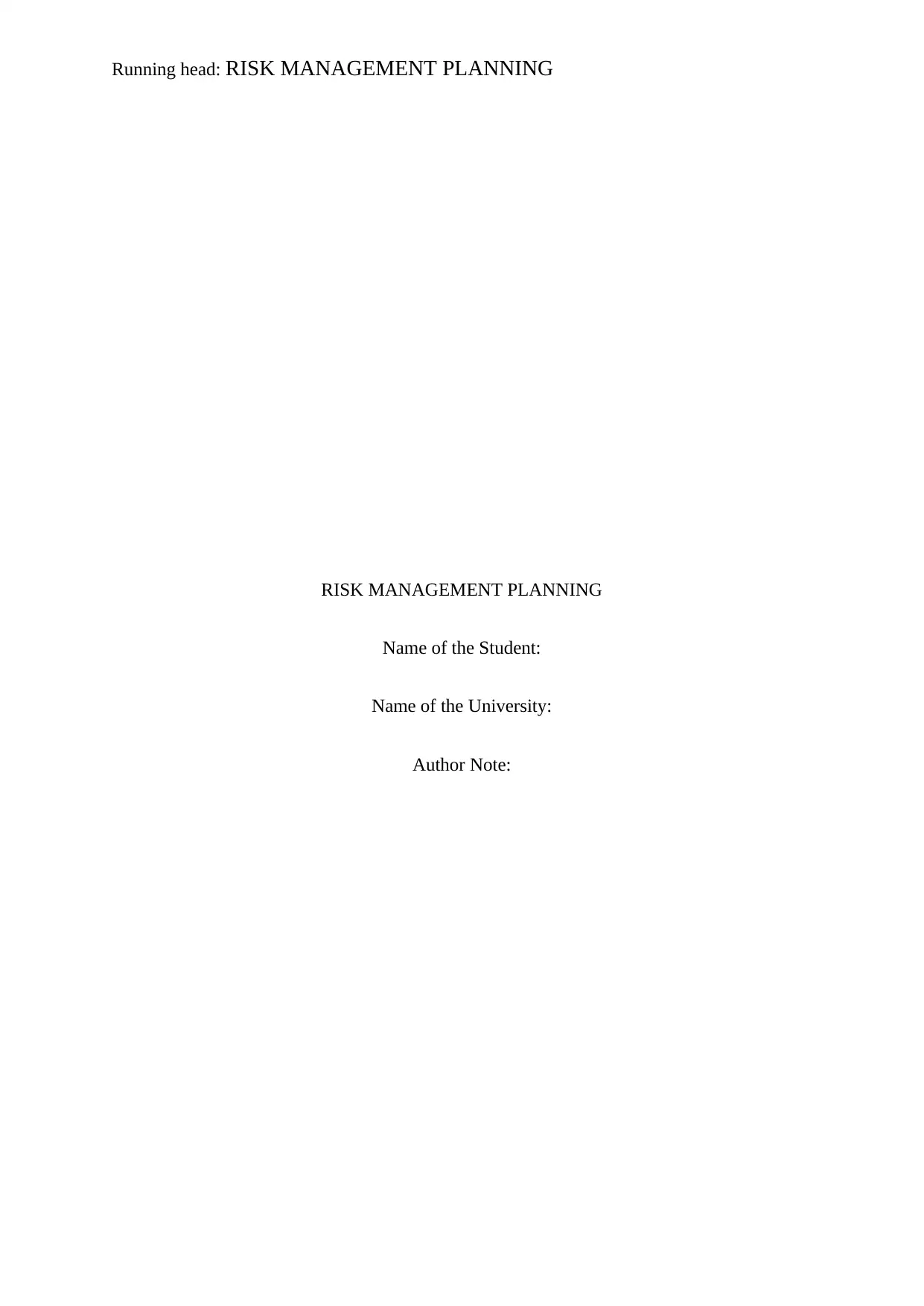
Running head: RISK MANAGEMENT PLANNING
RISK MANAGEMENT PLANNING
Name of the Student:
Name of the University:
Author Note:
RISK MANAGEMENT PLANNING
Name of the Student:
Name of the University:
Author Note:
Paraphrase This Document
Need a fresh take? Get an instant paraphrase of this document with our AI Paraphraser
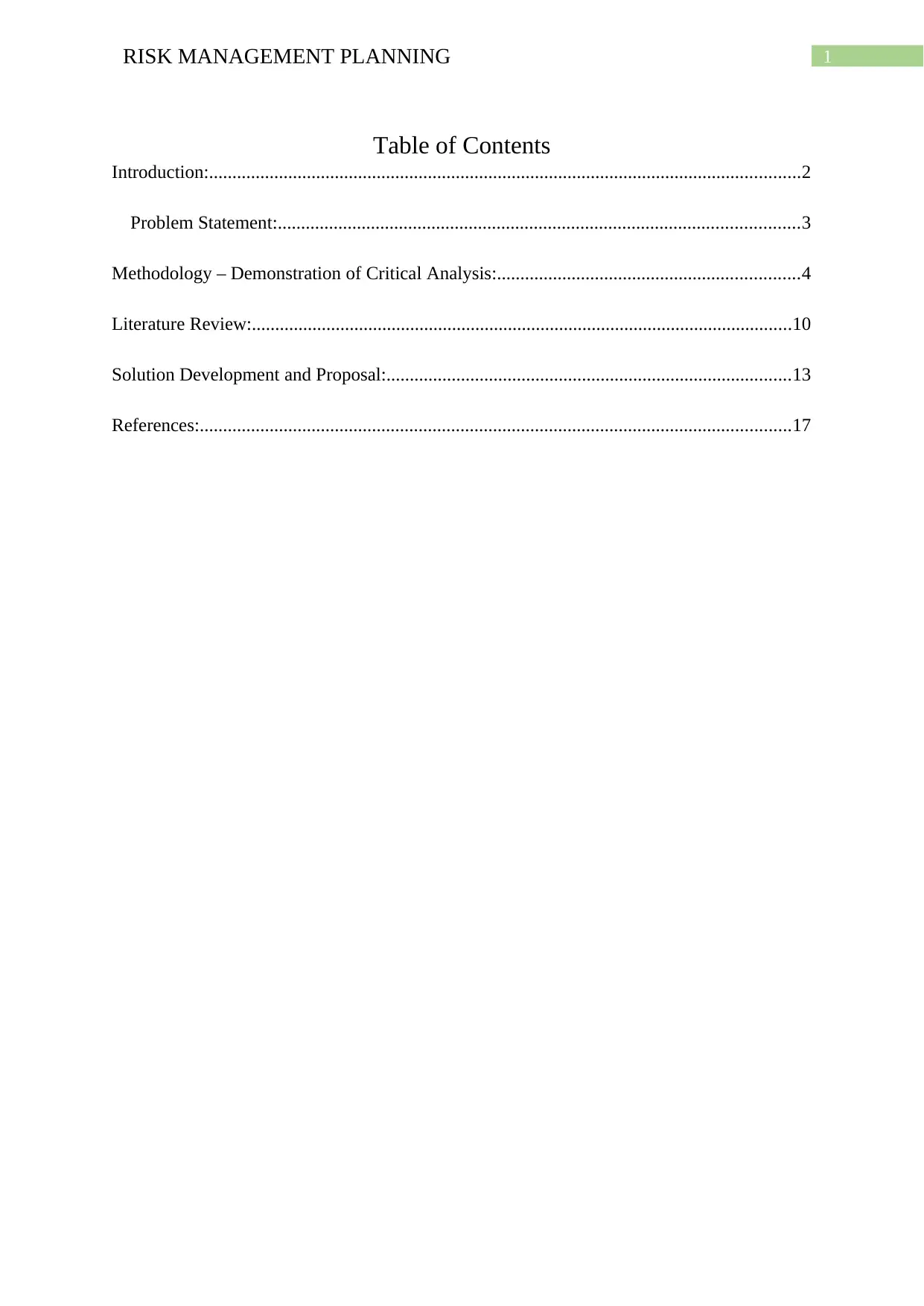
1RISK MANAGEMENT PLANNING
Table of Contents
Introduction:...............................................................................................................................2
Problem Statement:................................................................................................................3
Methodology – Demonstration of Critical Analysis:.................................................................4
Literature Review:....................................................................................................................10
Solution Development and Proposal:.......................................................................................13
References:...............................................................................................................................17
Table of Contents
Introduction:...............................................................................................................................2
Problem Statement:................................................................................................................3
Methodology – Demonstration of Critical Analysis:.................................................................4
Literature Review:....................................................................................................................10
Solution Development and Proposal:.......................................................................................13
References:...............................................................................................................................17
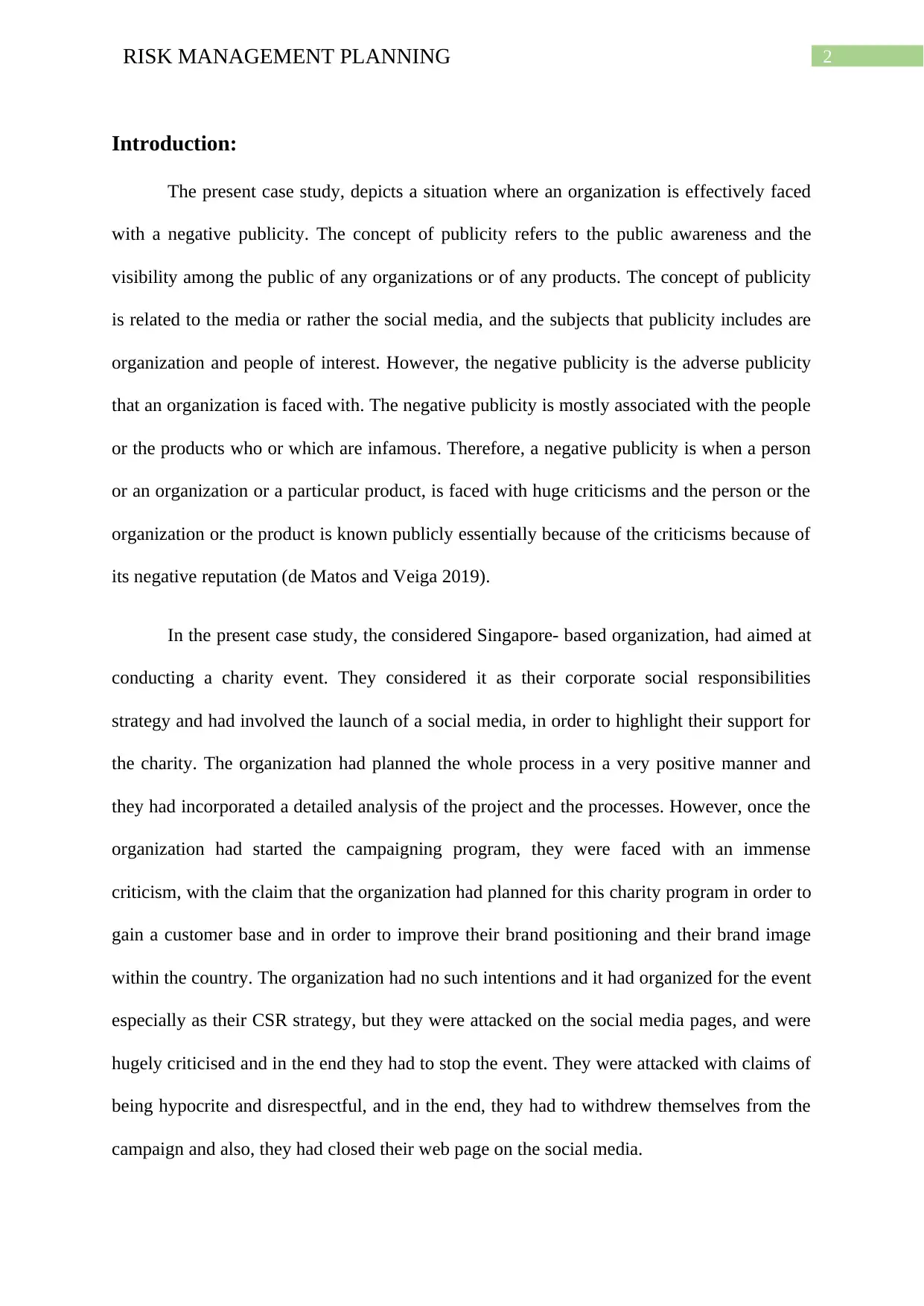
2RISK MANAGEMENT PLANNING
Introduction:
The present case study, depicts a situation where an organization is effectively faced
with a negative publicity. The concept of publicity refers to the public awareness and the
visibility among the public of any organizations or of any products. The concept of publicity
is related to the media or rather the social media, and the subjects that publicity includes are
organization and people of interest. However, the negative publicity is the adverse publicity
that an organization is faced with. The negative publicity is mostly associated with the people
or the products who or which are infamous. Therefore, a negative publicity is when a person
or an organization or a particular product, is faced with huge criticisms and the person or the
organization or the product is known publicly essentially because of the criticisms because of
its negative reputation (de Matos and Veiga 2019).
In the present case study, the considered Singapore- based organization, had aimed at
conducting a charity event. They considered it as their corporate social responsibilities
strategy and had involved the launch of a social media, in order to highlight their support for
the charity. The organization had planned the whole process in a very positive manner and
they had incorporated a detailed analysis of the project and the processes. However, once the
organization had started the campaigning program, they were faced with an immense
criticism, with the claim that the organization had planned for this charity program in order to
gain a customer base and in order to improve their brand positioning and their brand image
within the country. The organization had no such intentions and it had organized for the event
especially as their CSR strategy, but they were attacked on the social media pages, and were
hugely criticised and in the end they had to stop the event. They were attacked with claims of
being hypocrite and disrespectful, and in the end, they had to withdrew themselves from the
campaign and also, they had closed their web page on the social media.
Introduction:
The present case study, depicts a situation where an organization is effectively faced
with a negative publicity. The concept of publicity refers to the public awareness and the
visibility among the public of any organizations or of any products. The concept of publicity
is related to the media or rather the social media, and the subjects that publicity includes are
organization and people of interest. However, the negative publicity is the adverse publicity
that an organization is faced with. The negative publicity is mostly associated with the people
or the products who or which are infamous. Therefore, a negative publicity is when a person
or an organization or a particular product, is faced with huge criticisms and the person or the
organization or the product is known publicly essentially because of the criticisms because of
its negative reputation (de Matos and Veiga 2019).
In the present case study, the considered Singapore- based organization, had aimed at
conducting a charity event. They considered it as their corporate social responsibilities
strategy and had involved the launch of a social media, in order to highlight their support for
the charity. The organization had planned the whole process in a very positive manner and
they had incorporated a detailed analysis of the project and the processes. However, once the
organization had started the campaigning program, they were faced with an immense
criticism, with the claim that the organization had planned for this charity program in order to
gain a customer base and in order to improve their brand positioning and their brand image
within the country. The organization had no such intentions and it had organized for the event
especially as their CSR strategy, but they were attacked on the social media pages, and were
hugely criticised and in the end they had to stop the event. They were attacked with claims of
being hypocrite and disrespectful, and in the end, they had to withdrew themselves from the
campaign and also, they had closed their web page on the social media.
⊘ This is a preview!⊘
Do you want full access?
Subscribe today to unlock all pages.

Trusted by 1+ million students worldwide
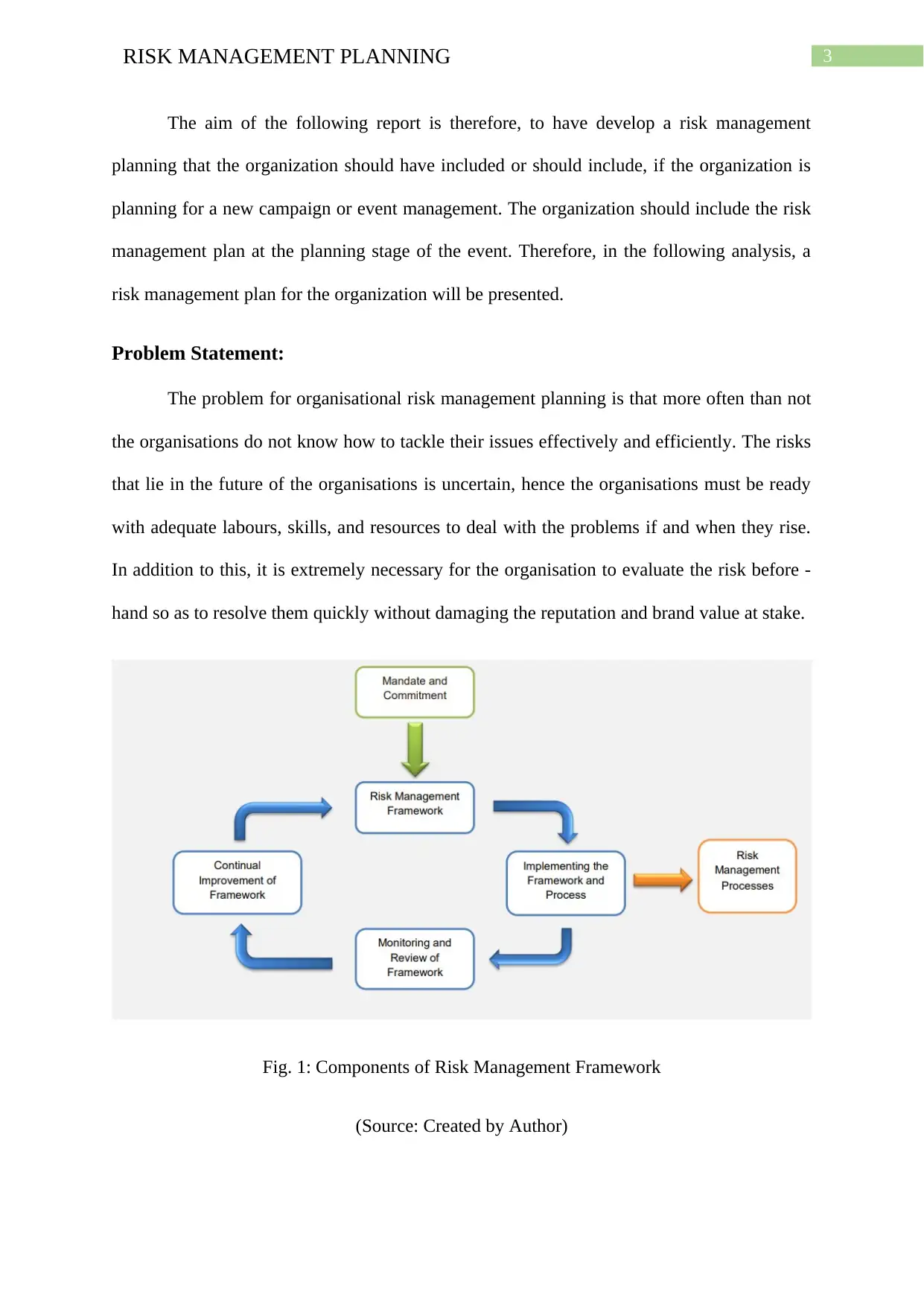
3RISK MANAGEMENT PLANNING
The aim of the following report is therefore, to have develop a risk management
planning that the organization should have included or should include, if the organization is
planning for a new campaign or event management. The organization should include the risk
management plan at the planning stage of the event. Therefore, in the following analysis, a
risk management plan for the organization will be presented.
Problem Statement:
The problem for organisational risk management planning is that more often than not
the organisations do not know how to tackle their issues effectively and efficiently. The risks
that lie in the future of the organisations is uncertain, hence the organisations must be ready
with adequate labours, skills, and resources to deal with the problems if and when they rise.
In addition to this, it is extremely necessary for the organisation to evaluate the risk before -
hand so as to resolve them quickly without damaging the reputation and brand value at stake.
Fig. 1: Components of Risk Management Framework
(Source: Created by Author)
The aim of the following report is therefore, to have develop a risk management
planning that the organization should have included or should include, if the organization is
planning for a new campaign or event management. The organization should include the risk
management plan at the planning stage of the event. Therefore, in the following analysis, a
risk management plan for the organization will be presented.
Problem Statement:
The problem for organisational risk management planning is that more often than not
the organisations do not know how to tackle their issues effectively and efficiently. The risks
that lie in the future of the organisations is uncertain, hence the organisations must be ready
with adequate labours, skills, and resources to deal with the problems if and when they rise.
In addition to this, it is extremely necessary for the organisation to evaluate the risk before -
hand so as to resolve them quickly without damaging the reputation and brand value at stake.
Fig. 1: Components of Risk Management Framework
(Source: Created by Author)
Paraphrase This Document
Need a fresh take? Get an instant paraphrase of this document with our AI Paraphraser
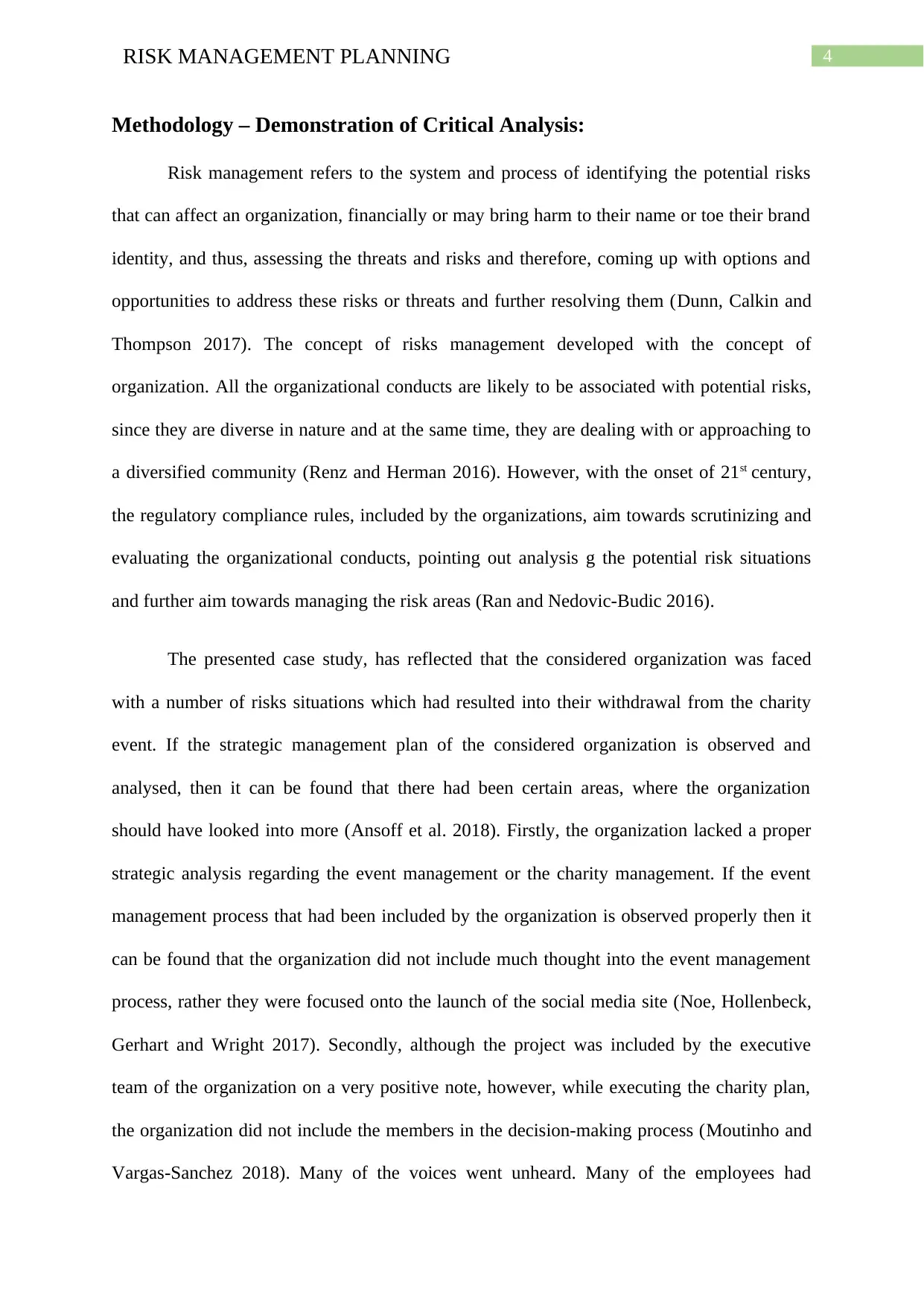
4RISK MANAGEMENT PLANNING
Methodology – Demonstration of Critical Analysis:
Risk management refers to the system and process of identifying the potential risks
that can affect an organization, financially or may bring harm to their name or toe their brand
identity, and thus, assessing the threats and risks and therefore, coming up with options and
opportunities to address these risks or threats and further resolving them (Dunn, Calkin and
Thompson 2017). The concept of risks management developed with the concept of
organization. All the organizational conducts are likely to be associated with potential risks,
since they are diverse in nature and at the same time, they are dealing with or approaching to
a diversified community (Renz and Herman 2016). However, with the onset of 21st century,
the regulatory compliance rules, included by the organizations, aim towards scrutinizing and
evaluating the organizational conducts, pointing out analysis g the potential risk situations
and further aim towards managing the risk areas (Ran and Nedovic-Budic 2016).
The presented case study, has reflected that the considered organization was faced
with a number of risks situations which had resulted into their withdrawal from the charity
event. If the strategic management plan of the considered organization is observed and
analysed, then it can be found that there had been certain areas, where the organization
should have looked into more (Ansoff et al. 2018). Firstly, the organization lacked a proper
strategic analysis regarding the event management or the charity management. If the event
management process that had been included by the organization is observed properly then it
can be found that the organization did not include much thought into the event management
process, rather they were focused onto the launch of the social media site (Noe, Hollenbeck,
Gerhart and Wright 2017). Secondly, although the project was included by the executive
team of the organization on a very positive note, however, while executing the charity plan,
the organization did not include the members in the decision-making process (Moutinho and
Vargas-Sanchez 2018). Many of the voices went unheard. Many of the employees had
Methodology – Demonstration of Critical Analysis:
Risk management refers to the system and process of identifying the potential risks
that can affect an organization, financially or may bring harm to their name or toe their brand
identity, and thus, assessing the threats and risks and therefore, coming up with options and
opportunities to address these risks or threats and further resolving them (Dunn, Calkin and
Thompson 2017). The concept of risks management developed with the concept of
organization. All the organizational conducts are likely to be associated with potential risks,
since they are diverse in nature and at the same time, they are dealing with or approaching to
a diversified community (Renz and Herman 2016). However, with the onset of 21st century,
the regulatory compliance rules, included by the organizations, aim towards scrutinizing and
evaluating the organizational conducts, pointing out analysis g the potential risk situations
and further aim towards managing the risk areas (Ran and Nedovic-Budic 2016).
The presented case study, has reflected that the considered organization was faced
with a number of risks situations which had resulted into their withdrawal from the charity
event. If the strategic management plan of the considered organization is observed and
analysed, then it can be found that there had been certain areas, where the organization
should have looked into more (Ansoff et al. 2018). Firstly, the organization lacked a proper
strategic analysis regarding the event management or the charity management. If the event
management process that had been included by the organization is observed properly then it
can be found that the organization did not include much thought into the event management
process, rather they were focused onto the launch of the social media site (Noe, Hollenbeck,
Gerhart and Wright 2017). Secondly, although the project was included by the executive
team of the organization on a very positive note, however, while executing the charity plan,
the organization did not include the members in the decision-making process (Moutinho and
Vargas-Sanchez 2018). Many of the voices went unheard. Many of the employees had
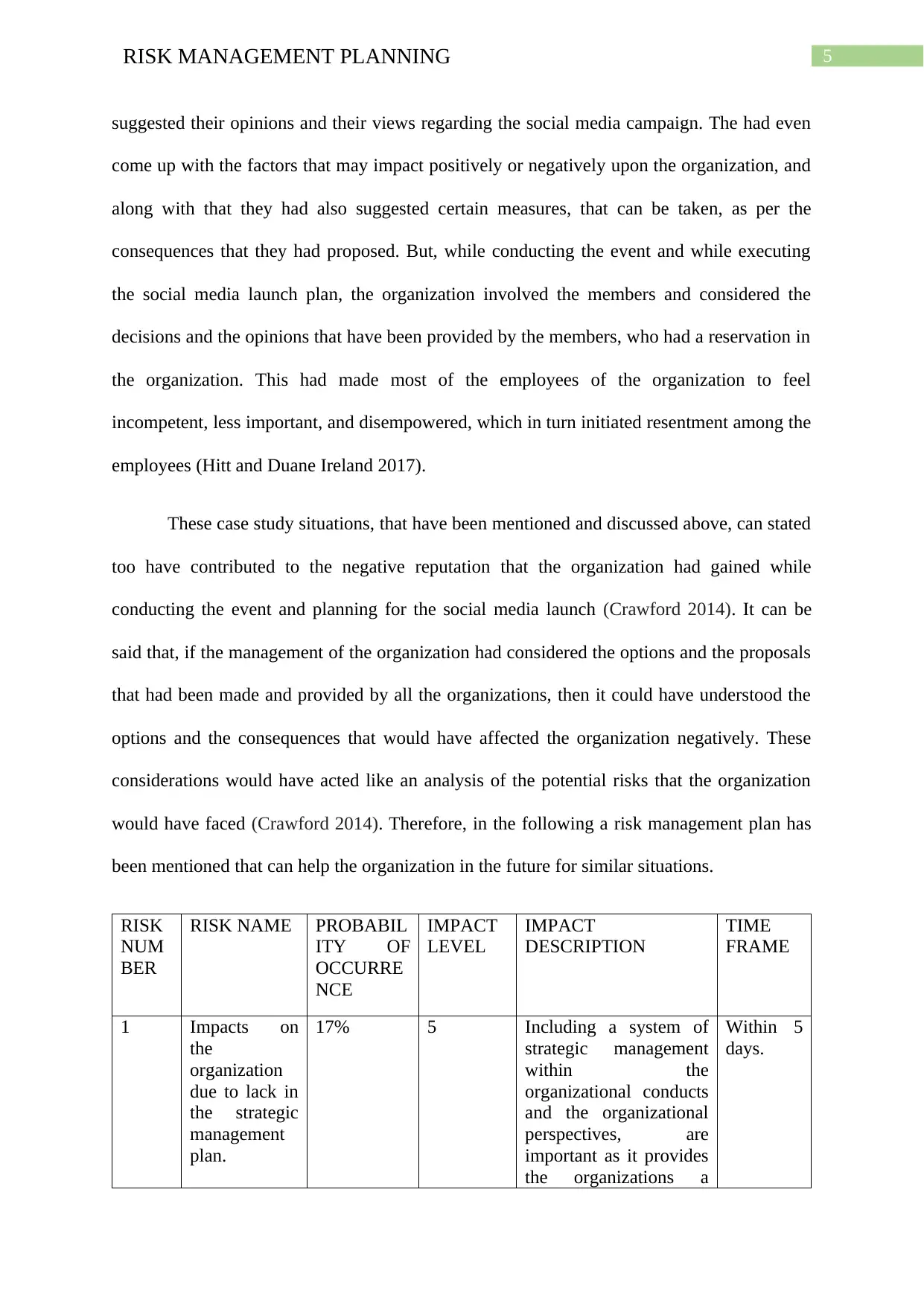
5RISK MANAGEMENT PLANNING
suggested their opinions and their views regarding the social media campaign. The had even
come up with the factors that may impact positively or negatively upon the organization, and
along with that they had also suggested certain measures, that can be taken, as per the
consequences that they had proposed. But, while conducting the event and while executing
the social media launch plan, the organization involved the members and considered the
decisions and the opinions that have been provided by the members, who had a reservation in
the organization. This had made most of the employees of the organization to feel
incompetent, less important, and disempowered, which in turn initiated resentment among the
employees (Hitt and Duane Ireland 2017).
These case study situations, that have been mentioned and discussed above, can stated
too have contributed to the negative reputation that the organization had gained while
conducting the event and planning for the social media launch (Crawford 2014). It can be
said that, if the management of the organization had considered the options and the proposals
that had been made and provided by all the organizations, then it could have understood the
options and the consequences that would have affected the organization negatively. These
considerations would have acted like an analysis of the potential risks that the organization
would have faced (Crawford 2014). Therefore, in the following a risk management plan has
been mentioned that can help the organization in the future for similar situations.
RISK
NUM
BER
RISK NAME PROBABIL
ITY OF
OCCURRE
NCE
IMPACT
LEVEL
IMPACT
DESCRIPTION
TIME
FRAME
1 Impacts on
the
organization
due to lack in
the strategic
management
plan.
17% 5 Including a system of
strategic management
within the
organizational conducts
and the organizational
perspectives, are
important as it provides
the organizations a
Within 5
days.
suggested their opinions and their views regarding the social media campaign. The had even
come up with the factors that may impact positively or negatively upon the organization, and
along with that they had also suggested certain measures, that can be taken, as per the
consequences that they had proposed. But, while conducting the event and while executing
the social media launch plan, the organization involved the members and considered the
decisions and the opinions that have been provided by the members, who had a reservation in
the organization. This had made most of the employees of the organization to feel
incompetent, less important, and disempowered, which in turn initiated resentment among the
employees (Hitt and Duane Ireland 2017).
These case study situations, that have been mentioned and discussed above, can stated
too have contributed to the negative reputation that the organization had gained while
conducting the event and planning for the social media launch (Crawford 2014). It can be
said that, if the management of the organization had considered the options and the proposals
that had been made and provided by all the organizations, then it could have understood the
options and the consequences that would have affected the organization negatively. These
considerations would have acted like an analysis of the potential risks that the organization
would have faced (Crawford 2014). Therefore, in the following a risk management plan has
been mentioned that can help the organization in the future for similar situations.
RISK
NUM
BER
RISK NAME PROBABIL
ITY OF
OCCURRE
NCE
IMPACT
LEVEL
IMPACT
DESCRIPTION
TIME
FRAME
1 Impacts on
the
organization
due to lack in
the strategic
management
plan.
17% 5 Including a system of
strategic management
within the
organizational conducts
and the organizational
perspectives, are
important as it provides
the organizations a
Within 5
days.
⊘ This is a preview!⊘
Do you want full access?
Subscribe today to unlock all pages.

Trusted by 1+ million students worldwide
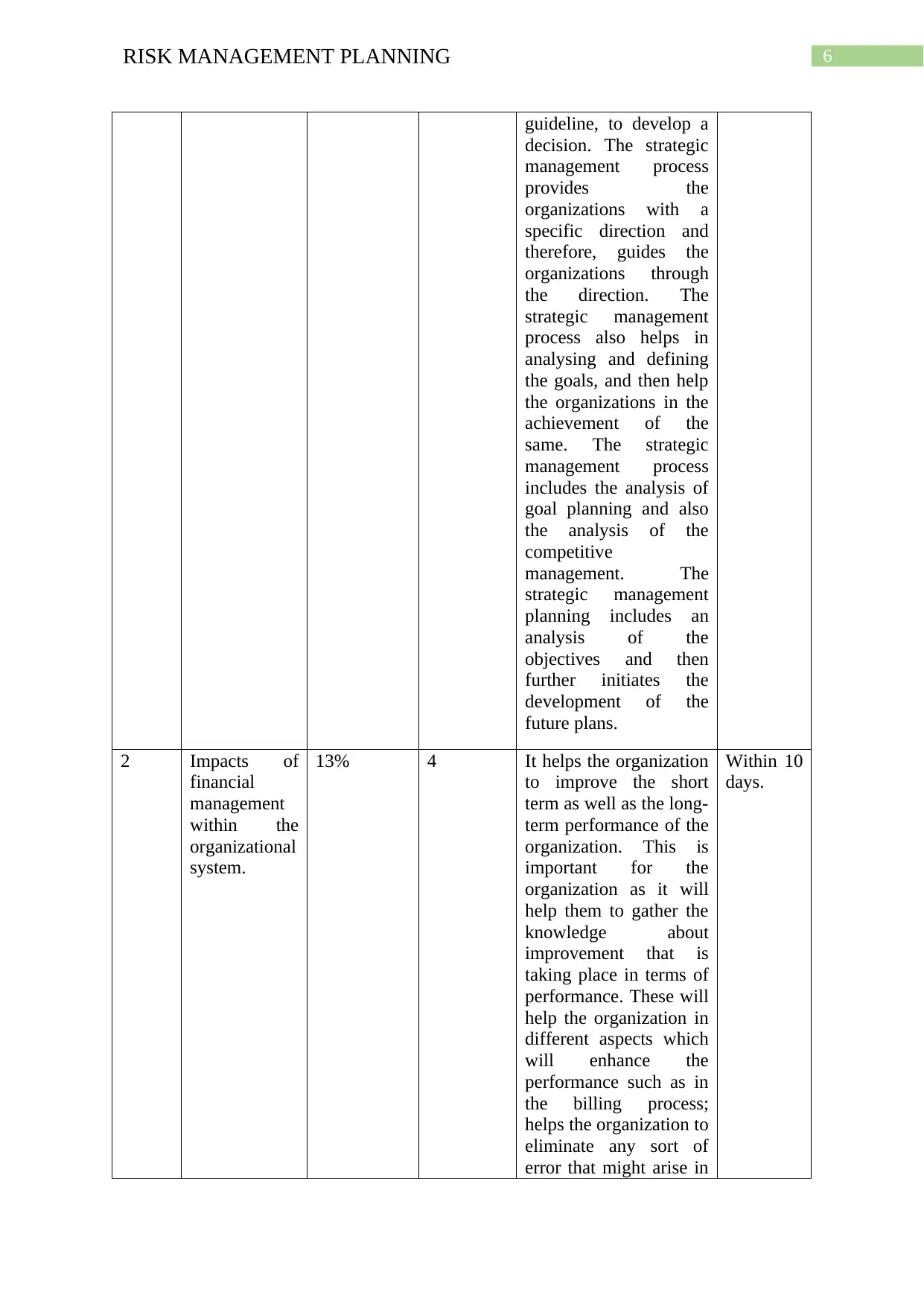
6RISK MANAGEMENT PLANNING
guideline, to develop a
decision. The strategic
management process
provides the
organizations with a
specific direction and
therefore, guides the
organizations through
the direction. The
strategic management
process also helps in
analysing and defining
the goals, and then help
the organizations in the
achievement of the
same. The strategic
management process
includes the analysis of
goal planning and also
the analysis of the
competitive
management. The
strategic management
planning includes an
analysis of the
objectives and then
further initiates the
development of the
future plans.
2 Impacts of
financial
management
within the
organizational
system.
13% 4 It helps the organization
to improve the short
term as well as the long-
term performance of the
organization. This is
important for the
organization as it will
help them to gather the
knowledge about
improvement that is
taking place in terms of
performance. These will
help the organization in
different aspects which
will enhance the
performance such as in
the billing process;
helps the organization to
eliminate any sort of
error that might arise in
Within 10
days.
guideline, to develop a
decision. The strategic
management process
provides the
organizations with a
specific direction and
therefore, guides the
organizations through
the direction. The
strategic management
process also helps in
analysing and defining
the goals, and then help
the organizations in the
achievement of the
same. The strategic
management process
includes the analysis of
goal planning and also
the analysis of the
competitive
management. The
strategic management
planning includes an
analysis of the
objectives and then
further initiates the
development of the
future plans.
2 Impacts of
financial
management
within the
organizational
system.
13% 4 It helps the organization
to improve the short
term as well as the long-
term performance of the
organization. This is
important for the
organization as it will
help them to gather the
knowledge about
improvement that is
taking place in terms of
performance. These will
help the organization in
different aspects which
will enhance the
performance such as in
the billing process;
helps the organization to
eliminate any sort of
error that might arise in
Within 10
days.
Paraphrase This Document
Need a fresh take? Get an instant paraphrase of this document with our AI Paraphraser
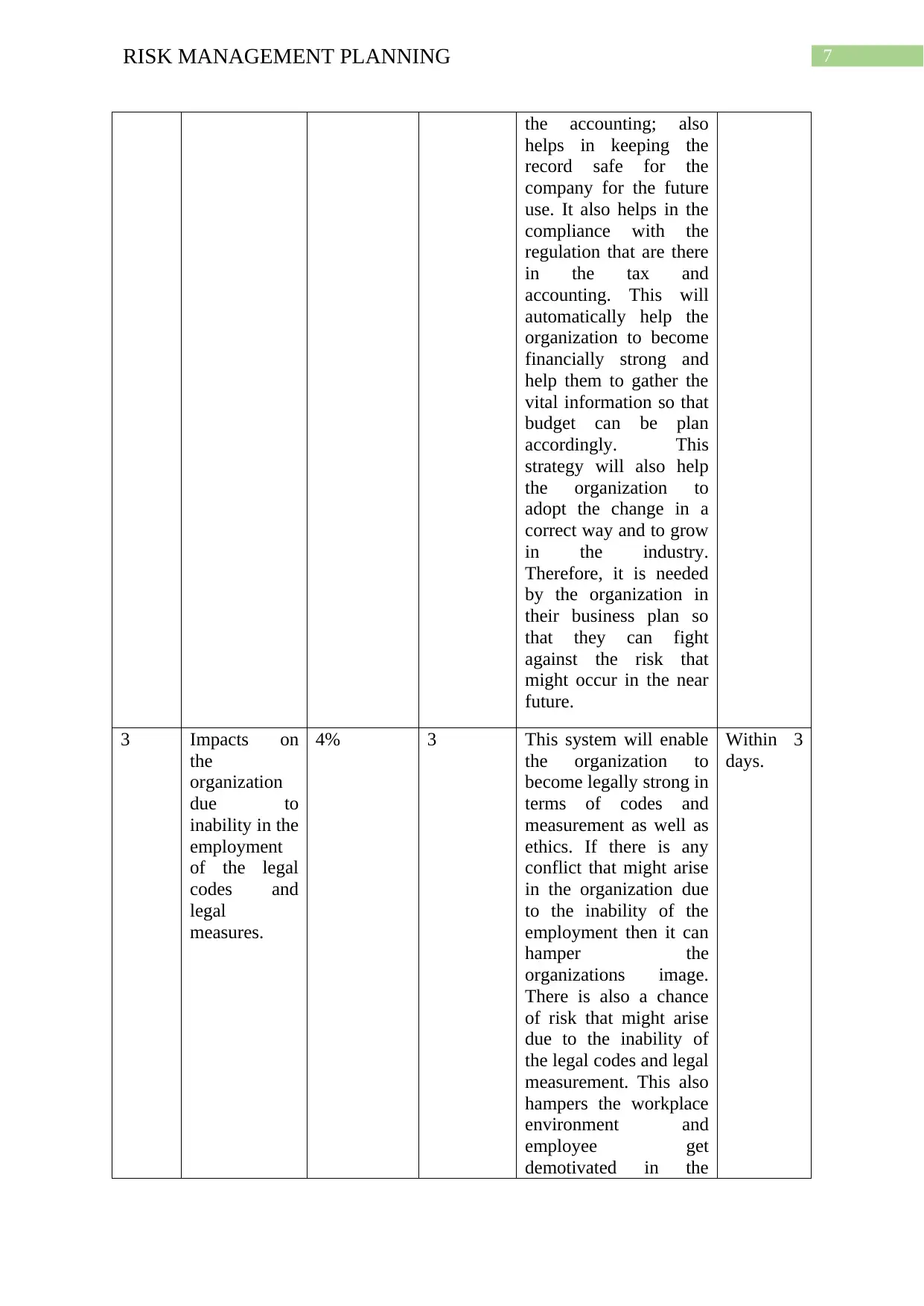
7RISK MANAGEMENT PLANNING
the accounting; also
helps in keeping the
record safe for the
company for the future
use. It also helps in the
compliance with the
regulation that are there
in the tax and
accounting. This will
automatically help the
organization to become
financially strong and
help them to gather the
vital information so that
budget can be plan
accordingly. This
strategy will also help
the organization to
adopt the change in a
correct way and to grow
in the industry.
Therefore, it is needed
by the organization in
their business plan so
that they can fight
against the risk that
might occur in the near
future.
3 Impacts on
the
organization
due to
inability in the
employment
of the legal
codes and
legal
measures.
4% 3 This system will enable
the organization to
become legally strong in
terms of codes and
measurement as well as
ethics. If there is any
conflict that might arise
in the organization due
to the inability of the
employment then it can
hamper the
organizations image.
There is also a chance
of risk that might arise
due to the inability of
the legal codes and legal
measurement. This also
hampers the workplace
environment and
employee get
demotivated in the
Within 3
days.
the accounting; also
helps in keeping the
record safe for the
company for the future
use. It also helps in the
compliance with the
regulation that are there
in the tax and
accounting. This will
automatically help the
organization to become
financially strong and
help them to gather the
vital information so that
budget can be plan
accordingly. This
strategy will also help
the organization to
adopt the change in a
correct way and to grow
in the industry.
Therefore, it is needed
by the organization in
their business plan so
that they can fight
against the risk that
might occur in the near
future.
3 Impacts on
the
organization
due to
inability in the
employment
of the legal
codes and
legal
measures.
4% 3 This system will enable
the organization to
become legally strong in
terms of codes and
measurement as well as
ethics. If there is any
conflict that might arise
in the organization due
to the inability of the
employment then it can
hamper the
organizations image.
There is also a chance
of risk that might arise
due to the inability of
the legal codes and legal
measurement. This also
hampers the workplace
environment and
employee get
demotivated in the
Within 3
days.
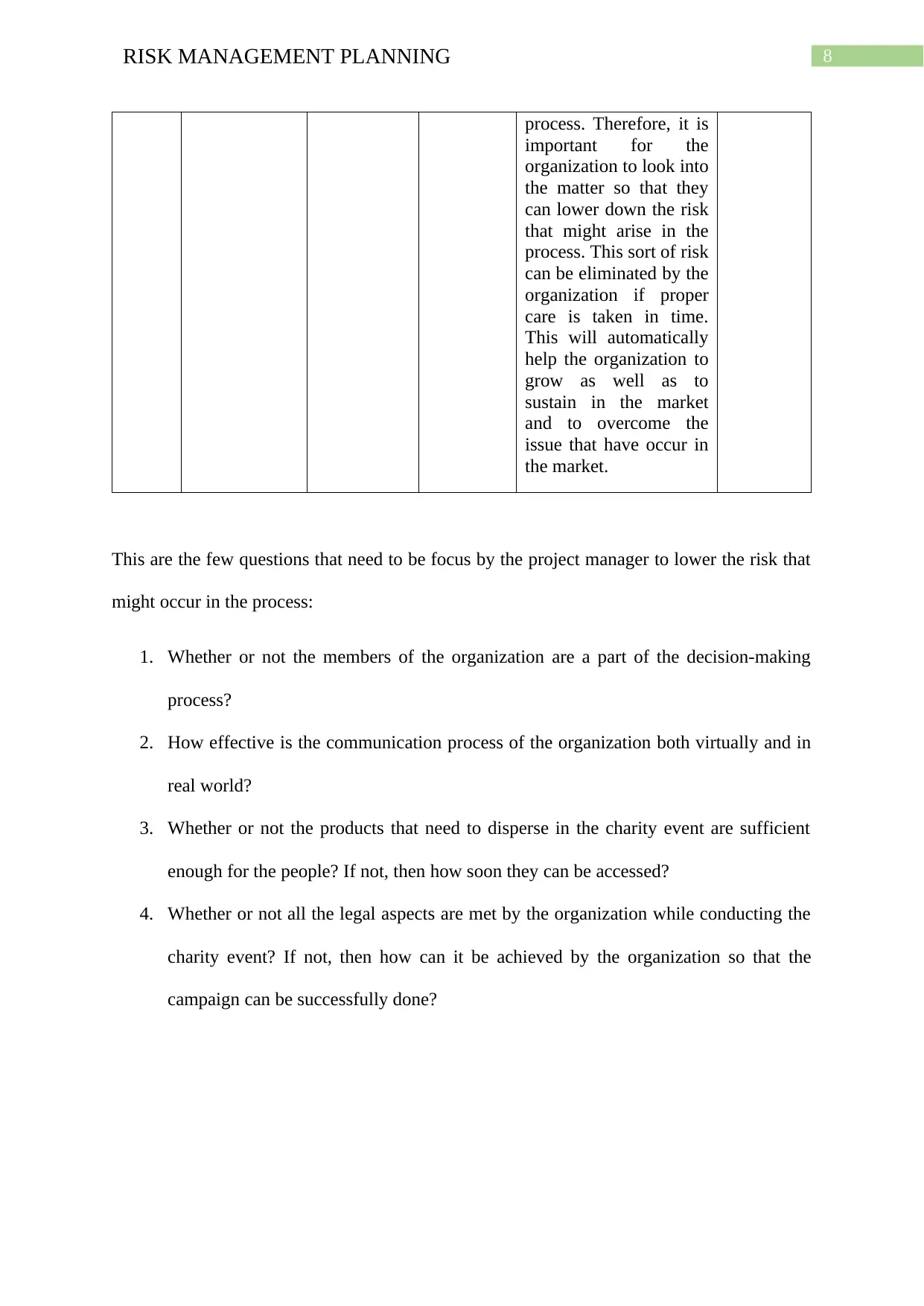
8RISK MANAGEMENT PLANNING
process. Therefore, it is
important for the
organization to look into
the matter so that they
can lower down the risk
that might arise in the
process. This sort of risk
can be eliminated by the
organization if proper
care is taken in time.
This will automatically
help the organization to
grow as well as to
sustain in the market
and to overcome the
issue that have occur in
the market.
This are the few questions that need to be focus by the project manager to lower the risk that
might occur in the process:
1. Whether or not the members of the organization are a part of the decision-making
process?
2. How effective is the communication process of the organization both virtually and in
real world?
3. Whether or not the products that need to disperse in the charity event are sufficient
enough for the people? If not, then how soon they can be accessed?
4. Whether or not all the legal aspects are met by the organization while conducting the
charity event? If not, then how can it be achieved by the organization so that the
campaign can be successfully done?
process. Therefore, it is
important for the
organization to look into
the matter so that they
can lower down the risk
that might arise in the
process. This sort of risk
can be eliminated by the
organization if proper
care is taken in time.
This will automatically
help the organization to
grow as well as to
sustain in the market
and to overcome the
issue that have occur in
the market.
This are the few questions that need to be focus by the project manager to lower the risk that
might occur in the process:
1. Whether or not the members of the organization are a part of the decision-making
process?
2. How effective is the communication process of the organization both virtually and in
real world?
3. Whether or not the products that need to disperse in the charity event are sufficient
enough for the people? If not, then how soon they can be accessed?
4. Whether or not all the legal aspects are met by the organization while conducting the
charity event? If not, then how can it be achieved by the organization so that the
campaign can be successfully done?
⊘ This is a preview!⊘
Do you want full access?
Subscribe today to unlock all pages.

Trusted by 1+ million students worldwide
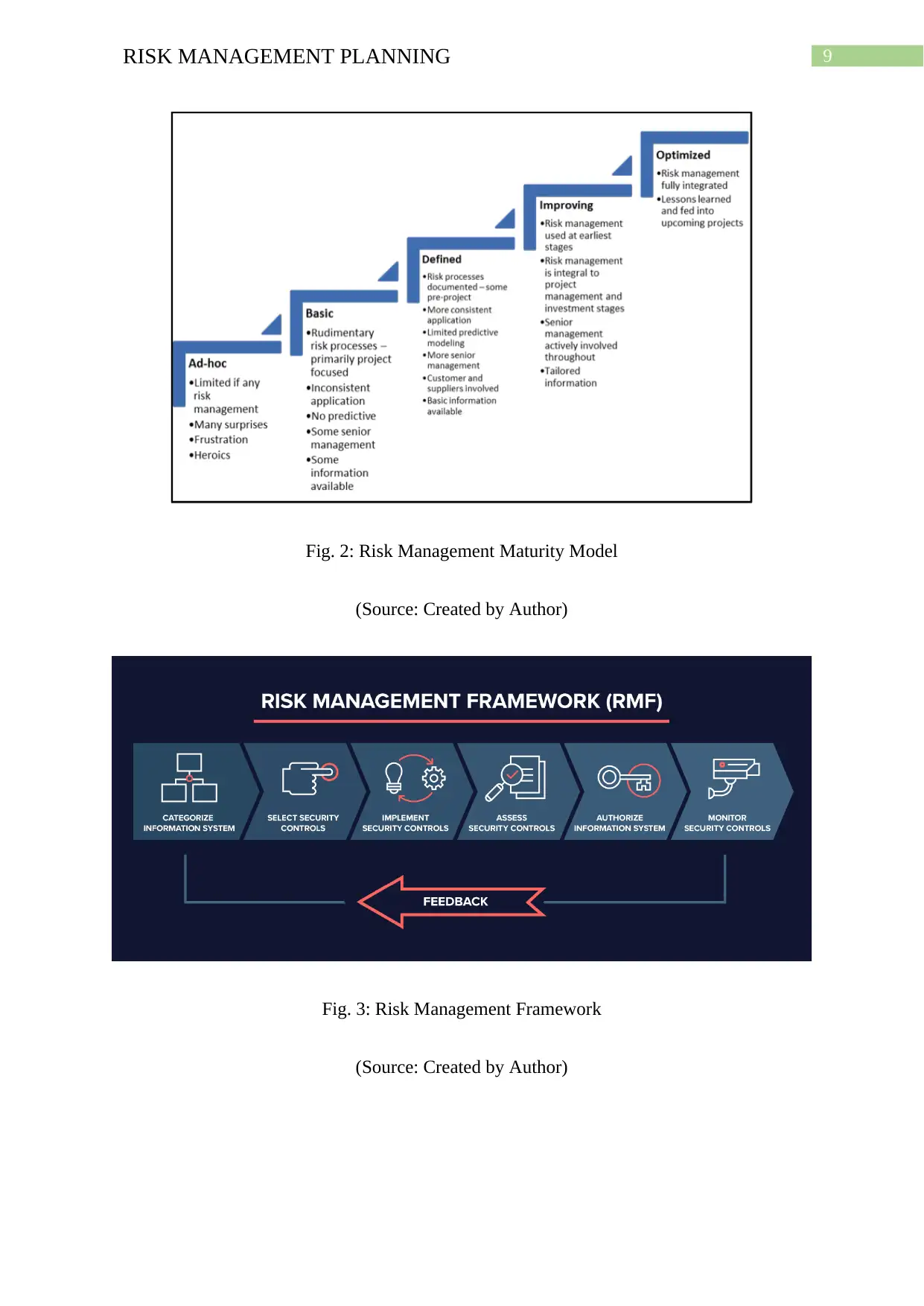
9RISK MANAGEMENT PLANNING
Fig. 2: Risk Management Maturity Model
(Source: Created by Author)
Fig. 3: Risk Management Framework
(Source: Created by Author)
Fig. 2: Risk Management Maturity Model
(Source: Created by Author)
Fig. 3: Risk Management Framework
(Source: Created by Author)
Paraphrase This Document
Need a fresh take? Get an instant paraphrase of this document with our AI Paraphraser
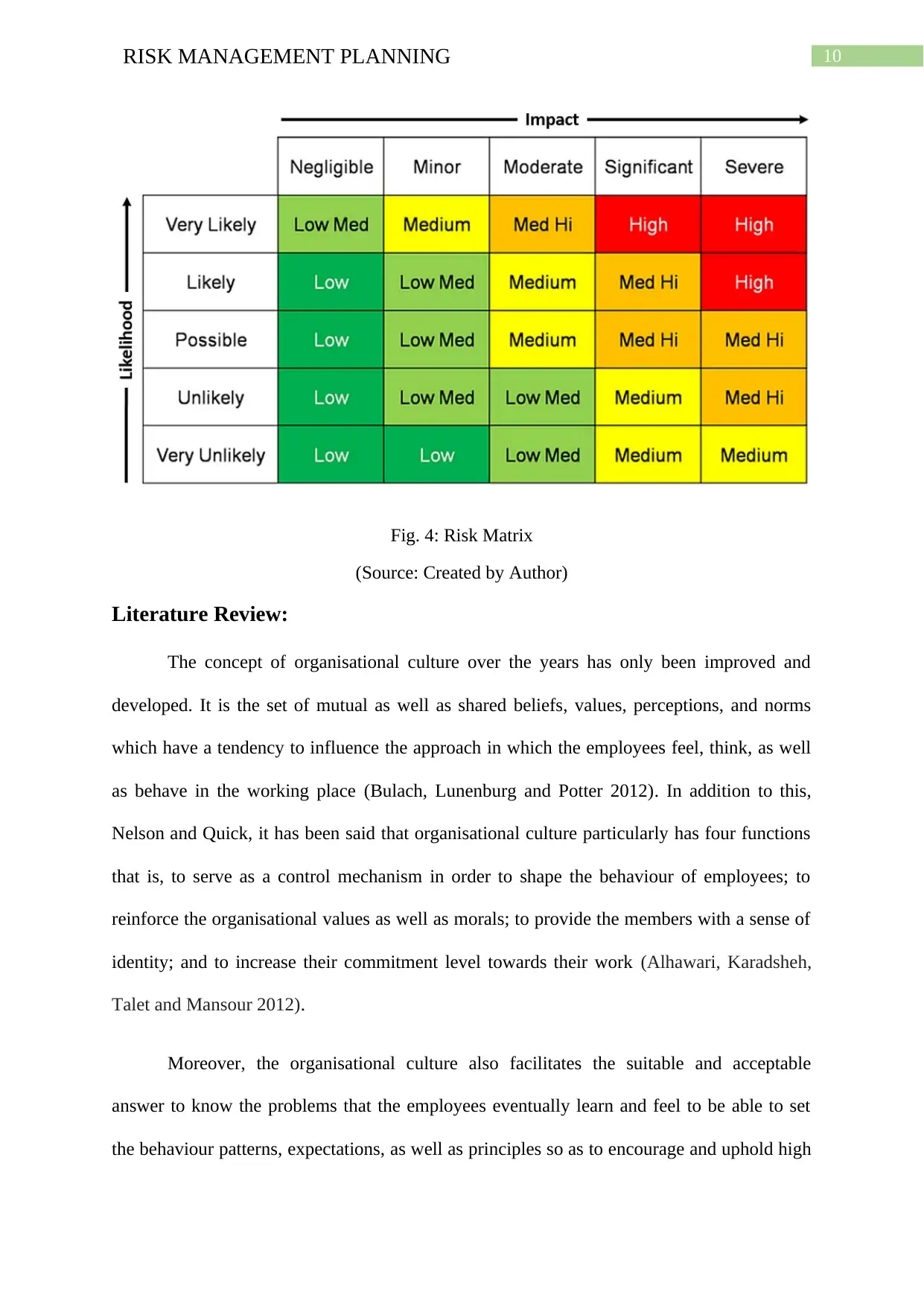
10RISK MANAGEMENT PLANNING
Fig. 4: Risk Matrix
(Source: Created by Author)
Literature Review:
The concept of organisational culture over the years has only been improved and
developed. It is the set of mutual as well as shared beliefs, values, perceptions, and norms
which have a tendency to influence the approach in which the employees feel, think, as well
as behave in the working place (Bulach, Lunenburg and Potter 2012). In addition to this,
Nelson and Quick, it has been said that organisational culture particularly has four functions
that is, to serve as a control mechanism in order to shape the behaviour of employees; to
reinforce the organisational values as well as morals; to provide the members with a sense of
identity; and to increase their commitment level towards their work (Alhawari, Karadsheh,
Talet and Mansour 2012).
Moreover, the organisational culture also facilitates the suitable and acceptable
answer to know the problems that the employees eventually learn and feel to be able to set
the behaviour patterns, expectations, as well as principles so as to encourage and uphold high
Fig. 4: Risk Matrix
(Source: Created by Author)
Literature Review:
The concept of organisational culture over the years has only been improved and
developed. It is the set of mutual as well as shared beliefs, values, perceptions, and norms
which have a tendency to influence the approach in which the employees feel, think, as well
as behave in the working place (Bulach, Lunenburg and Potter 2012). In addition to this,
Nelson and Quick, it has been said that organisational culture particularly has four functions
that is, to serve as a control mechanism in order to shape the behaviour of employees; to
reinforce the organisational values as well as morals; to provide the members with a sense of
identity; and to increase their commitment level towards their work (Alhawari, Karadsheh,
Talet and Mansour 2012).
Moreover, the organisational culture also facilitates the suitable and acceptable
answer to know the problems that the employees eventually learn and feel to be able to set
the behaviour patterns, expectations, as well as principles so as to encourage and uphold high
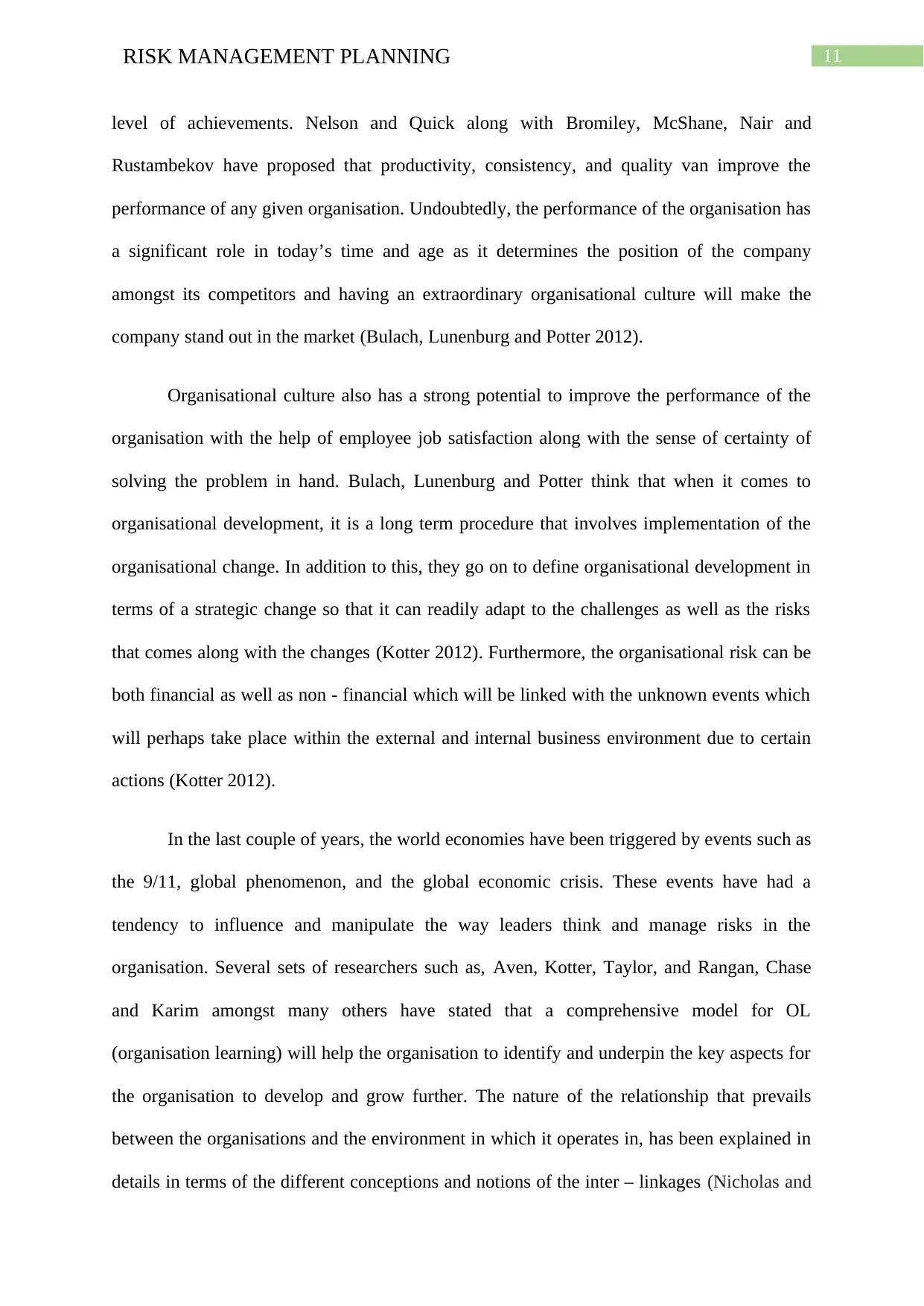
11RISK MANAGEMENT PLANNING
level of achievements. Nelson and Quick along with Bromiley, McShane, Nair and
Rustambekov have proposed that productivity, consistency, and quality van improve the
performance of any given organisation. Undoubtedly, the performance of the organisation has
a significant role in today’s time and age as it determines the position of the company
amongst its competitors and having an extraordinary organisational culture will make the
company stand out in the market (Bulach, Lunenburg and Potter 2012).
Organisational culture also has a strong potential to improve the performance of the
organisation with the help of employee job satisfaction along with the sense of certainty of
solving the problem in hand. Bulach, Lunenburg and Potter think that when it comes to
organisational development, it is a long term procedure that involves implementation of the
organisational change. In addition to this, they go on to define organisational development in
terms of a strategic change so that it can readily adapt to the challenges as well as the risks
that comes along with the changes (Kotter 2012). Furthermore, the organisational risk can be
both financial as well as non - financial which will be linked with the unknown events which
will perhaps take place within the external and internal business environment due to certain
actions (Kotter 2012).
In the last couple of years, the world economies have been triggered by events such as
the 9/11, global phenomenon, and the global economic crisis. These events have had a
tendency to influence and manipulate the way leaders think and manage risks in the
organisation. Several sets of researchers such as, Aven, Kotter, Taylor, and Rangan, Chase
and Karim amongst many others have stated that a comprehensive model for OL
(organisation learning) will help the organisation to identify and underpin the key aspects for
the organisation to develop and grow further. The nature of the relationship that prevails
between the organisations and the environment in which it operates in, has been explained in
details in terms of the different conceptions and notions of the inter – linkages (Nicholas and
level of achievements. Nelson and Quick along with Bromiley, McShane, Nair and
Rustambekov have proposed that productivity, consistency, and quality van improve the
performance of any given organisation. Undoubtedly, the performance of the organisation has
a significant role in today’s time and age as it determines the position of the company
amongst its competitors and having an extraordinary organisational culture will make the
company stand out in the market (Bulach, Lunenburg and Potter 2012).
Organisational culture also has a strong potential to improve the performance of the
organisation with the help of employee job satisfaction along with the sense of certainty of
solving the problem in hand. Bulach, Lunenburg and Potter think that when it comes to
organisational development, it is a long term procedure that involves implementation of the
organisational change. In addition to this, they go on to define organisational development in
terms of a strategic change so that it can readily adapt to the challenges as well as the risks
that comes along with the changes (Kotter 2012). Furthermore, the organisational risk can be
both financial as well as non - financial which will be linked with the unknown events which
will perhaps take place within the external and internal business environment due to certain
actions (Kotter 2012).
In the last couple of years, the world economies have been triggered by events such as
the 9/11, global phenomenon, and the global economic crisis. These events have had a
tendency to influence and manipulate the way leaders think and manage risks in the
organisation. Several sets of researchers such as, Aven, Kotter, Taylor, and Rangan, Chase
and Karim amongst many others have stated that a comprehensive model for OL
(organisation learning) will help the organisation to identify and underpin the key aspects for
the organisation to develop and grow further. The nature of the relationship that prevails
between the organisations and the environment in which it operates in, has been explained in
details in terms of the different conceptions and notions of the inter – linkages (Nicholas and
⊘ This is a preview!⊘
Do you want full access?
Subscribe today to unlock all pages.

Trusted by 1+ million students worldwide
1 out of 20
Related Documents
Your All-in-One AI-Powered Toolkit for Academic Success.
+13062052269
info@desklib.com
Available 24*7 on WhatsApp / Email
![[object Object]](/_next/static/media/star-bottom.7253800d.svg)
Unlock your academic potential
Copyright © 2020–2025 A2Z Services. All Rights Reserved. Developed and managed by ZUCOL.





